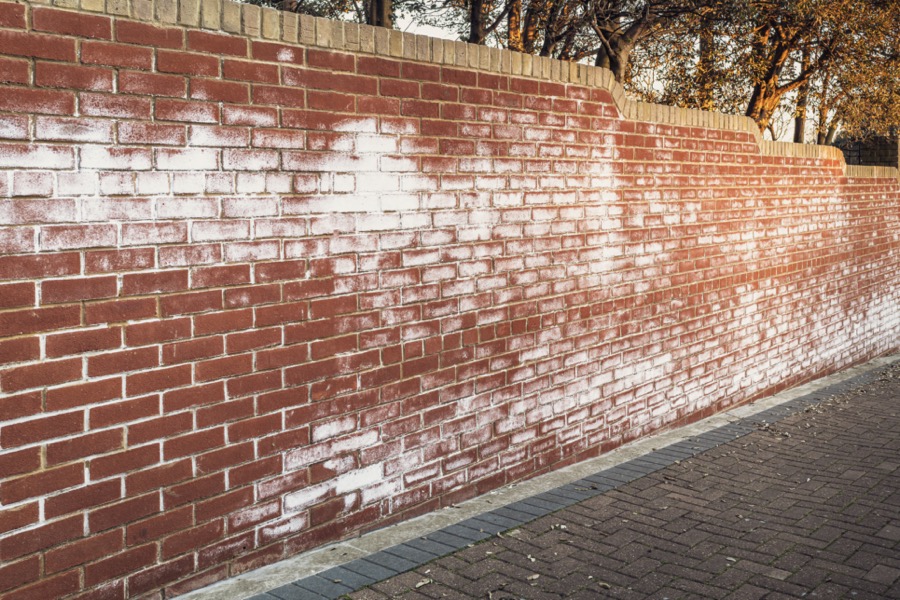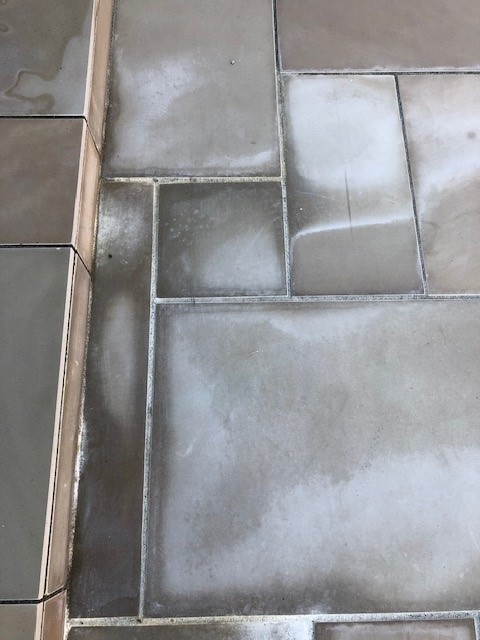
Outdoors
COMMON PROBLEMS WITH EFFLORESCENCE
A Guide for Professionals

As landscape professionals, we’ve all seen efflorescence many times before and understand that it’s only a temporary inconvenience, but to the inexperienced home owner that has just made a big investment into the patio paving slabs, the appearance of unsightly white patches on their beautiful newly laid patio can be quite concerning. This section aims to help industry professional educate their clients in the existence of efflorescence and to help reassure and manage their customers expectations, resulting in happier customers and an easier life for everyone.
What is efflorescence?
Efflorescence is the migration of a salt to the surface of a porous material. These salts in the case of paving installations are held within the paving itself but also in the sub-base used in its installation, these salts are transferred to the surface of the stone when wet, this process is known as capillary action. The salt water migrates to the surface of the stone where it evaporates leaving white salty deposits behind.

How to help reduce efflorescence
Efflorescence is a natural occurring process and as such, it is virtually impossible to eliminate all possibility of it occurring, however there are a few installation measures that can be taken to help reduce the intensity of the occurrence, including:
1. Use land based aggregates in your installation, these will have a much lower salt content than aggregates that are dredged from the sea.
2. Ensure that there is sufficient drainage under your patio area, especially in poorly drainage substrate such as clay soils, this can normally be improved by installing a porous sub-base such as MOT type 1 crushed limestone at a minimum dept of 100mm, with
additional drainage underneath if deemed necessary. This is especially important when using porous pointing materials as you do not want to impede the flow of water away from your paving.
3. Ensuring adequate run off for the paving and sub-base, to prevent water from sitting underneath or on the surface of the paving.
4. Ensure that your paving is laid on a solid base not spot bedded, this will reduce the possibility of water sitting and getting trapped under the paving slabs and will also help improve the visual appearance of the effloresces release, as it will be more even and not showing in unsightly patches on the surface on the stone.
5. You may wish to consider sealing your natural stone to help minimise the risk of moisture being absorbed through the surface of the stone. If you are considering this, ensure that your sealer does not trap the efflorescence deposits inside the stone, but allows the salt to escape through the natural process.
How to clean off efflorescence
In the vast majority of case efflorescence will natural disperse though use and exposure to the elements and will disappear over a period of a couple of months, without the need for any additional cleaning.
If you would prefer to speed up the process we would recommend using a stiff bristled brush (non metal) and clean running water, or a light clean with a pressure washer, being careful not to damage any pointing. Ensure you completely remove the water from the surface of the stone after cleaning, or crystals may remain that can cause efflorescence too reappear. If the efflorescence returns it will mean the factors causing it have not yet stopped, and the area will need to be cleaned again.
After you have tried the above method and are still finding you are getting persistent stubborn efflorescence staining, you can use an efflorescence cleaner that is specifically formulated for natural stone. These products must only be used as directed and you must read fully the application instructions and health and safety guidance before application. We would also recommend testing any products on an inconspicuous area first to ensure you are happy with the final result.
Please ensure that you do not use acidic cleaners to remove efflorescence, as this can cause permanent, irreparable, damage to the colour and structure of the stone.he effects of using this method.
NATURAL STONE AND TIMBER LTD WILL NOT TAKE ANY RESPONSIBILITY FOR PROBLEMS CAUSED IF THE PRODUCT IS INSTALLED INCORRECTLY.
IF YOU NEED ANY ADVICE PLEASE CONTACT A MEMBER OF STAFF AT YOUR LOCAL DEPOT, ON ONE OF THE NUMBERS BELOW, WHO WILL BE HAPPY TO ADVISE YOU ON ANY OF OUR PRODUCTS.

